During a typical 30-minute thrill show, the American Motor Drome Company sends all manner of wheeled conveyance up the 15-foot-high, hardwood-planked, vertical face of its famous Wall of Death —everything from single-speed bicycles to Briggs & Stratton go-karts to buzzy two-stroke Aermacchi dirt bikes—but the grand finale always features star rider Charlie Ransom aboard his bike of choice, a beautifully dilapidated 1926 Indian Scout. Ransom rides an antique Indian because professional wall riders have always preferred Indians , and Ransom wants in every way to honor the American thrill show tradition. Besides, Ransom explains, the Indian is just a better bike.
“No one rode Harleys back then,” Ransom says. “They were a single-downtube, keystone frame, and the footboards were connected by scrap metal. They just weren’t good. When the stunt riders found the Scout, they never looked back. It’s got a short wheelbase, excellent power-to-weight ratio, gear drive, everything you want. It’s awesome.”
American Motor Drome Company presently counts six vintage Scouts in its fleet. Ransom’s favorite, the ’26 model, has been a stunt bike since the 1930s. A friend unearthed it in an abandoned warehouse in Milwaukee (of all places) a few years ago, in virtually the same condition it’s in today. “We changed the seat and front wheel, and it was ready to ride,” Ransom says. “That’s it. It starts up the first kick every time!”
The Scout shows no sign of slowing down, nor does Ransom. He’s been wall riding for 13 years, since he literally stumbled upon the AMDCo silodrome on the side of the road near his Northern California home and found his calling in life. “Let’s just say I was in the right place in my life for something like this,” Ransom says smiling and leaving us to wonder just what a life looks like when riding a motorcycle around a vertical wall is the best next move. “It engulfed me,” Ransom explains. “I was doing whatever before, but this is it for me. Until the good Lord comes and snatches me up, I’ll be doing this. I can’t think of anything else.”
And no doubt he’ll still be riding his Scout.
Although often overshadowed by the better-known Chief, the 101 Scout, built from 1928 to ’31, is considered by many to be the best motorcycle Indian ever made. Longer and lower than the original Scout and powered by a bigger, 745cc (45ci) V-twin, the fast and fine-handling 101 Scout was the preferred mount for a generation of racers.
Six years after standard Scout production ceased in 1942 to accommodate wartime demands, Indian built a special run of 50 “Big Base” 648 Sport Scouts to homologate for AMA racing. Floyd Emde rode a 648 to victory in the 1948 Daytona 200, and the 648 shown here, originally sold to Chicago Indian dealer Pete Monte, was raced in the ’50s by the father/son team of Ray and Bob Shingler. The Shinglers rebuilt the bike for vintage racing in the mid-1980s, and it’s been roadraced and flat tracked almost continuously since then.
Hill climbing was the most popular form of motorsports in the 1920s, and Indian’s in-house race shop created this hill-climbing special, based on a first-generation Scout with the 745cc V-twin that debuted in 1927, expressly for the purpose of sprinting up dirt hillsides as quickly as possible. This particular bike was first raced by multi-time AMA national hill-climbing champion Bob Armstrong, who was drowned in a tragic boating accident in 1930, at age 21.
After discontinuing production of the original V-twin powered Scout in 1942, Indian revived the famous name in 1949 to adorn a new line of small-displacement, overhead-valve parallel twins designed to compete with the lightweight British machines that were then flooding the American market. This effort was ultimately too little too late, but Gurnee, Illinois’ Analog Motorcycles shows that the short-lived second Scout makes a great platform for a traditional, Continental-styled café racer.










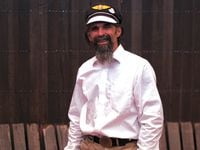
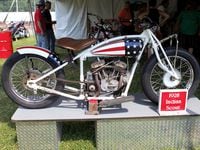
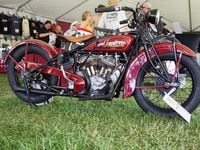
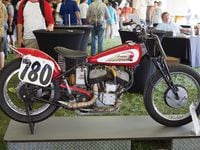
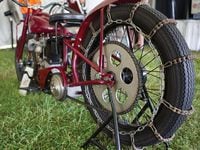
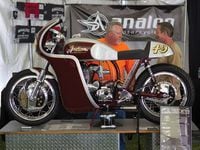
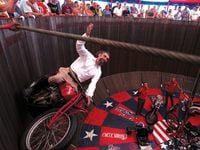
/cloudfront-us-east-1.images.arcpublishing.com/octane/TNOU5DNE2BC57MFPMGN2EIDXAM.jpg)
/cloudfront-us-east-1.images.arcpublishing.com/octane/GTCXACQGJ5HAPDTGWUQKDEH44E.jpg)
/cloudfront-us-east-1.images.arcpublishing.com/octane/S35YGSEMEZB4BLTDJTSZPF4GLA.jpg)
/cloudfront-us-east-1.images.arcpublishing.com/octane/5UOT6HPX2JFMRJAX6EH45AR4MQ.jpg)
/cloudfront-us-east-1.images.arcpublishing.com/octane/OKWOJWAKP5EP3OACCRRWPCIX2Q.jpg)
/cloudfront-us-east-1.images.arcpublishing.com/octane/2WF3SCE3NFBQXLDNJM7KMXA45E.jpg)
/cloudfront-us-east-1.images.arcpublishing.com/octane/G4MG6OUCJNBSHIS2MVVOTPX65E.jpg)
/cloudfront-us-east-1.images.arcpublishing.com/octane/IIGGWFOTOJGB7DB6DGBXCCMTDY.jpg)
/cloudfront-us-east-1.images.arcpublishing.com/octane/QSTCM6AVEZA5JJBUXNIQ3DSOF4.jpg)
/cloudfront-us-east-1.images.arcpublishing.com/octane/U4I7G625B5DMLF2DVIJDFZVV6M.jpg)
/cloudfront-us-east-1.images.arcpublishing.com/octane/B6XD6LS6IVCQPIU6HXDJSM3FHY.jpg)
/cloudfront-us-east-1.images.arcpublishing.com/octane/ICL63FEDDRDTTMINYICCEYGMDA.jpg)
/cloudfront-us-east-1.images.arcpublishing.com/octane/FCGZHQXRBZFLBAPC5SDIQLVF4I.jpg)
/cloudfront-us-east-1.images.arcpublishing.com/octane/WNOB6LDOIFFHJKPSVIWDYUGOPM.jpg)

/cloudfront-us-east-1.images.arcpublishing.com/octane/X33NU3E525ECRHXLNUJN2FTRKI.jpg)
/cloudfront-us-east-1.images.arcpublishing.com/octane/6KKT5NNL2JAVBOXMZYS5ZO76YA.jpg)
/cloudfront-us-east-1.images.arcpublishing.com/octane/J5RKG5O455GMPGQRF2OG6LRT7A.jpg)
/cloudfront-us-east-1.images.arcpublishing.com/octane/GX2CIZKQVRH2TATDM26KFG2DAE.jpg)
/cloudfront-us-east-1.images.arcpublishing.com/octane/ZWIDYSAKQZHD5BHREMQILXJCGM.jpg)
/cloudfront-us-east-1.images.arcpublishing.com/octane/CYUHJZCTSJCH3MRAQEIKXK7SCQ.jpg)
/cloudfront-us-east-1.images.arcpublishing.com/octane/LKOFINY56FCXJCANJ5M7ZDQUBY.jpg)
/cloudfront-us-east-1.images.arcpublishing.com/octane/4NBPDACMWJH63JQYJVK3QRBDZI.jpg)
/cloudfront-us-east-1.images.arcpublishing.com/octane/KKHQHRR3FJGX7H2IPU6RALMWG4.jpg)